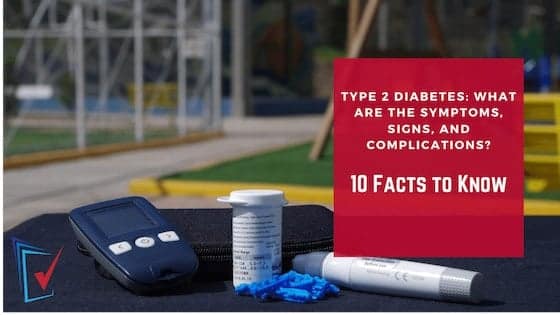Have you been wondering what the symptoms, signs, and complications of Type 2 diabetes are? In this
Type 2 Diabetes can affect people of all ages. Unfortunately, it's easy to miss the early symptoms, so sometimes, people won't even know they have a condition.
The estimates show that 1 out of every three people suffer from the early stages but may not be aware.
Diabetes affects the body's ability to metabolize carbohydrates for energy, causing high levels of blood sugar.
- Symptoms of Type 2 Diabetes
- Are You At Risk for Type 2 Diabetes?
- Can you Inherit Type 2 Diabetes?
- What are Women's Type 2 Diabetes Risks?
- Polycystic Ovary Syndrome
- How Does Insulin Work?
- Insulin Resistance
- How is Diabetes Diagnosed?
- Diabetes and Diet
- Diabetes and Exercise
- Reduce Stress
- Oral Medications
- Insulin
- Non-Insulin Injections
- Testing Your Blood Sugar
- Type 2 Diabetes and Heart Attacks
- Kidney Disease and Type 2 Diabetes
- Type 2 Diabetes and Your Eyes
- Nerve Pain Caused By Type 2 Diabetes
- Foot Conditions and Type 2 Diabetes
- How Do You Prevent Type 2 Diabetes?
- F.A.Q.
Having these increased blood sugar levels leads to significant health issues.
Some problems that can occur:
- Nerve problems
- Vision loss
- Joint deformities
- Cardiovascular disease
- Diabetic coma (life-threatening)
Symptoms of Type 2 Diabetes
Thirst
Even though people with Type 2 diabetes may not have the same specific symptoms, increased thirst is a characteristic. The increased thirst can be accompanied by other symptoms like frequent urination, starving, dry mouth, weight gain, or loss.
Headaches
Other symptoms can include headaches, blurred vision, and fatigue.
Infections
Unfortunately, many people discover they have a condition when certain infections and sores take an unusually long time to heal, frequent yeast infections, itchy skin, and urinary tract infections.

Sexual Disfunction
Diabetes damages the blood vessels and nerves in the sex organs, decreasing sensation leading to difficulties reaching an orgasm. Symptoms like vaginal dryness in women and impotence in men are complications you could face. They estimate that between 35% and 70% of men with diabetes will have impotence. The statistics for women are about 33% of women with diabetes will have sexual problems as well.
Are You At Risk for Type 2 Diabetes?
Certain risk factors related to your lifestyle choice and medical condition can increase your chances of developing Type 2 diabetes. These are:
- Cigarette smoking
- Being overweight or obese, especially around your waist.
- Lack of exercise
- Consuming a diet that's high in processed meat, fat, sweets, and red meats.
- Triglyceride levels over 250 mg/dl
- Having low levels of “good” HDL cholesterol. (below 35 mg/dl)
Can you Inherit Type 2 Diabetes?
We can't control some things, like our parents or siblings and specific demographics have a higher average risk factor. If your family is Hispanic, Native American, Asian, or African American, this will also increase your risk. If you're over 45 years old, you'll have a higher risk of Type 2 diabetes than younger people.
What are Women's Type 2 Diabetes Risks?
If you develop gestational diabetes during pregnancy, you'll have a higher chance of developing type 2 diabetes later in your life. The risk is the same for women who have babies larger than 9 pounds.
Polycystic Ovary Syndrome
Insulin resistance is a characteristic in this condition, developing multiple small cysts in the ovaries, irregular periods, and high androgen hormones.
How Does Insulin Work?
Insulin is a hormone that allows the body to turn glucose into energy efficiently. After your body breaks down the carbohydrates, it's converted into sugar in your stomach, and glucose enters your system, stimulating the pancreas to release the proper amount of insulin. Thus, insulin allows the body's cells to use glucose as fuel.
Insulin Resistance
In Type 2 Diabetes, the body cannot convert the glucose properly, leading to high glucose levels in the blood. Insulin resistance means that even though the body can produce insulin, the body's cells don't appropriately to the insulin being made. So, over time, the pancreas reduces the amount of insulin it produces.
How is Diabetes Diagnosed?
You can take a hemoglobin A1c test to measure the amount of hemoglobin bound to glucose in your blood, providing information about your average blood glucose levels over the past 2-3 months.
Hemoglobin A1c levels over 6.5% are indicative of diabetes. Another test you can take is the fasting blood glucose test. If your fasting blood glucose level is over 126, this affirms that diabetes is present. Likewise, anytime random blood glucose levels are over 200, this is consistent with diabetes.
Diabetes and Diet
Maintaining control over your blood sugar can help reduce complications from diabetes. Your doctor could refer you to a registered dietician counselor to help you create a healthy meal plan. If you have type 2 diabetes, you should monitor the number of carbohydrates, reduce the calories, and watch your fat and protein intake.
Diabetes and Exercise
Regular exercise, including walking, can help people with type 2 diabetes lower their blood glucose levels. Physical activity also reduces body fat, lowers blood pressure, and helps to prevent cardiovascular disease. They recommend at least 30 minutes of activity multiple times per week.
Reduce Stress
People with diabetes can benefit from simply reducing stress. Meditation, breathing exercises, and visualizations help manage the condition. Stress not only increases blood pressure but also increases blood glucose levels. Try plugging into social support networks, talk to your family or friends or join a church.
Oral Medications
Many doctors recommend that people with type 2 diabetes who cannot adequately control their blood sugar with proper diet and exercise take oral diabetes medications.
Different combinations of these pills will help increase insulin production or improve your body's insulin use, while others partially block the digestion of starches. Again, your doctor can help with this recommendation.
Insulin
Some people with type 2 diabetes also take insulin in combination with oral medications. They also use insulin for a condition called “beta-cell failure,” when your pancreas no longer produces insulin in response to elevated blood glucose, which happens with type 2 diabetes. If insulin isn't created, insulin treatment is necessary.
Non-Insulin Injections
There are other non-insulin drugs that you can inject to treat type 2 diabetes. Examples of these are liraglutide (Victoza), pramlintide (Symlin), exenatide (Byetta). These drugs stimulate the release of insulin.
Testing Your Blood Sugar
Your doctor can help suggest how often you should test your blood glucose level. In addition, testing helps to give you an idea if your management plan is working or if it needs to be changed. Typical times to test blood sugar is:
- First thing in the morning
- Before and after meals
- Before and after exercise
- Before bed
Type 2 Diabetes and Heart Attacks
Over time the elevated blood sugar levels will damage your blood vessels, which leads to an increased risk of blood clots, increasing the risk of a heart attack. As a result, around two out of every three diabetics die of heart disease. People with diabetes are also at increased risk for stroke because of the damage to the blood vessels.
Kidney Disease and Type 2 Diabetes
People with diabetes have an increased risk of developing chronic kidney disease over time.
Diabetes is the most common cause of renal failure, making up about 44% of cases. Keeping your diabetes under control can reduce the risk of kidney failure. Doctors prescribe medications to reduce the risk of kidney disease in diabetics.
Type 2 Diabetes and Your Eyes
Diabetic retinopathy is damage to the tiny blood vessels in the retina of your eye due to high blood sugar levels over time which can cause progressive and permanent vision loss. Diabetic retinopathy is the most common cause of new blindness in people between 20 and 74.
Nerve Pain Caused By Type 2 Diabetes
The tingling, numbness, and the sensation of “pins and needles” are all symptoms of diabetic neuropathy – meaning nerve damage related to diabetes. The most common is in the hands, feet, fingers, and toes. Controlling diabetes can help prevent this complication.
Foot Conditions and Type 2 Diabetes
Damage to blood vessels can reduce circulation in the feet of diabetics, making it hard to feel injuries, resulting in sores not healing correctly and even gangrene. In addition, amputation may be the result of severe cases.
How Do You Prevent Type 2 Diabetes?
Type 2 Diabetes is preventable and 100% reversible. It's possible to reduce the number of complications of diabetes by eating a healthy diet, getting moderate exercise, and maintaining a healthy weight. If you are at risk, regularly screening yourself for diabetes or prediabetes can alert you if a condition develops, and you can implement a management plan to reduce the risk of long-term problems. In addition, programs like Help Your Diabetes can help you reverse type 2 diabetes with their patented program.


